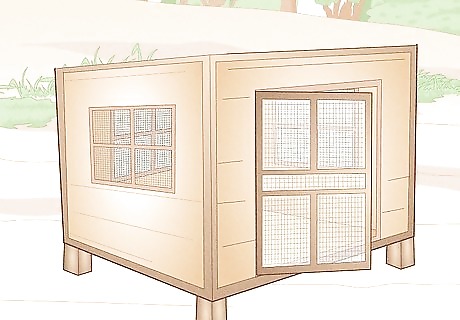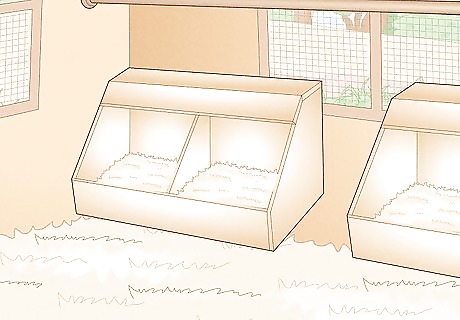
views
Capturing a Chicken At Nighttime

Consider waiting until Nighttime to catch your chicken. It is often easier to catch chickens at Nighttime. Chickens roost at night, making them less mobile and easier to catch off guard. If you have a coop you can catch them after they roost for the night on the roosting rods. If a chicken has escaped, find where it is roosting and catch it there. You should try to be as quiet and gentle as possible.

Approach the chicken quietly with a flashlight. Avoid making too much noise or sudden movements. Point the light towards the ground. If you are in the coop and shine the light directly at the birds on the roosting rod, you risk waking or startling them. Approach the chicken slowly.

Grab the chicken. You can do this slowly and gently without disturbing the whole coop. Cup your hands and grab the chicken over the wings. This will prevent the chicken from flapping its wings and disturbing the other birds. Hold it close to your body tightly, like you would a pet.
Catching A Chicken During the Daytime

Bait the chickens. Try putting a little bit of feed out and they will flock to it. Try doing this in your chicken coop if you have one. It is a more contained area and it will be easier to catch the chicken you want inside of it. If your chickens won't come to you for regular feed, you can try pieces of bread as a treat, but these should be used sparingly. Once chickens have flocked to their food, you can approach them.

Approach the chicken slowly from behind. If you move quickly, you will risk disturbing the hen and scaring her into a run. Be as quiet as possible. Don't make sudden movements. Hover over the chicken. This may cause the chicken to stop, crouch down and open its wings. This is what they do during mating.

Grasp the chicken. You can do this a number of ways. The easiest and gentlest way to grab a chicken is to bend down and gently scoop up the chicken. Keep your hands or arms over her wings so she can't flap them to get away. You can also grab the chicken by the back and tail. Cup your hands and scoop up the chicken gently, scooping up from underneath. If the chicken runs forward grasp the tail feathers and grab the chicken from the front by the shoulders. Avoid having to grab the tail feathers as much as possible, as chickens dislike this. You can also try to grab the chicken by its legs underneath. Avoid holding the chicken upside down from its legs if you do this.

Try using a poultry hook if you can't grab a chicken by hand. This is less gentle and quiet, but it is effective. Poultry hooks are long handled sticks with a hook made of wire on the end. Try hooking the chicken by the leg and pulling her toward you. You can also use a handled net to catch particularly stubborn bird.
Building a Chicken Coop To Prevent Your Chickens From Escaping

Prevent chickens from escaping by building a chicken coop. You should use a quality wood and high grade chicken wire. A chicken coop is a structure that will house chickens. Most chicken coops will be elevated structures with latched doors and chicken wire windows. Chicken wire will prevent the chickens from escaping and it will keep predators out. Most chicken coops will have roosting bars for the chickens to roost on and nesting boxes for the chickens to lay their eggs in.

Plan the chicken coop size. You will want the chickens to have enough room in the coop. Plan for at least 2-4 square feet of floor space per chicken in your flock. You will need a nesting box for every 3-4 chickens. For example, if you had 12 chickens, you would need at least 24 square feet of floor space and at least 6 nesting boxes.

Consider making elevation platforms for your chicken coop. Elevation is necessary to prevent predators from digging into the coop. You can elevate your coop with cement blocks, bricks, or a wooden platform. Lay out the size of the coop on the ground and place your elevation platforms at each corner. To make these more sturdy you might drive them into the ground to steady them.

Make your flooring. Most chicken coops have a wood flooring if they are raised from the ground. Plywood covered with inexpensive linoleum is a preferred and cost-effective chicken coop flooring. Linoleum covering on a chicken coop floor will be durable as well as easy to clean. If you have decided against elevating your chicken coop you can use a dirt floor, but this won't prevent predators. If you don't have an elevated coop, you can also lay out concrete for flooring. This will keep out predators and be simple to clean.

Build the sides and door of your chicken coop. You can start with a plywood frame. Make sure the coop is ventilated. This means that most of the sides should be windows rather than a solid wooden wall. Cover the open sides of the frame with a high-grade chicken wire. This will keep your chickens in the coop and predators out. Make a door with a latch. This latch should be a locking eye-hook type. Raccoons and other predators have been known to open sliding latches.

Build nesting boxes. This is where chickens will lay their eggs. These should be about 12 inches (30 cm) square. You will need one for every 3-4 chickens in the coop. You can place these at floor level or on a platform. If they are on a platform, build a small ramp or ladder so the chickens can climb into them.

Place roosting rods high in the chicken coop. These should be above the nesting boxes. If the roosts are placed below the nesting boxes, the chickens will be tempted to sleep in the nesting boxes. This will cause them to be soiled and unsuitable for eggs. Plan on using a wooden rod with at least 8 inches (20.3 cm) of space per chicken. Avoid metal roosting rods. These will get cold in the wintertime. Plastic should also be avoided as it can get slippery.

Build a secure roof. This can be sloped to avoid rainwater from collecting or flat. Make sure it is solid and free of holes. You don't want your chickens to be wet in the rain. You will also want to make sure your chickens have shade. Some chicken coop kits and plans have shingles for sealing the roof. You can use these or make your own.

Add bedding to the floor and nesting boxes of the coop. This will provide a cozy cushioning for the birds. Avoid using hay, as it can get moldy. Sand and sawdust can become wet, soiled, and harbor bacteria. Straw or pine shavings make the cleanest and best bedding.

Keep regular maintenance of the pen. You will have to make sure the coop is clean and free of escape points. You should plan on cleaning your chicken coop often. Chickens will soil the coop, so you need to replace the bedding and wash down the flooring regularly. Make sure the latches, chicken wire, and platform are secure and free of holes.




















Comments
0 comment